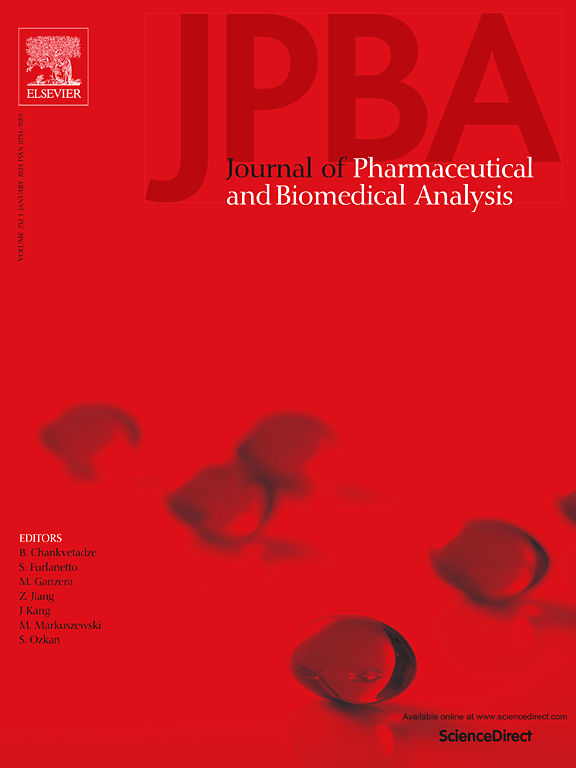Low polarity fraction of Radix Bupleuri alleviates chronic unpredictable mild stress-induced depression in rats through FXR modulating bile acid homeostasis in liver, gut, and brain
IF 3.1
3区 医学
Q2 CHEMISTRY, ANALYTICAL
Journal of pharmaceutical and biomedical analysis
Pub Date : 2024-10-15
DOI:10.1016/j.jpba.2024.116523
引用次数: 0
Abstract
Radix Bupleuri (BR, Bupleurum chinense DC.) is a well-known traditional Chinese medicine (TCM) known for its effects on soothing the liver and alleviating depression, and is widely used in clinical settings to manage depressive symptoms. A dosage of 12.5 g crude drug/kg/d of the low-polarity fraction of Radix Bupleuri (LBR) demonstrated effectiveness in treating depression in our previous study. However, the mechanism through which BR ameliorates depression remains unclear. This study aimed to explore the polar fractions of BR and their mechanisms of action in the treatment of depression. Chronic unpredictable mild stress (CUMS) rats were continuously administered BR by oral gavage for 4 weeks. Behavioral and biochemical indicators were evaluated to assess the antidepressant effects of LBR, and transcriptomics was used to explore the relevant pathways. In addition, pseudo-targeted bile acid (BA) metabonomics was used to quantify the BA profiles. Molecular biology techniques have been used to investigate the underlying mechanisms. LBR serves as a more effective active fraction with antidepressant activity. Intervention with LBR, which is characterized by a clearly defined chemical composition, significantly ameliorated depression-like behavior and biochemical indicators in rats subjected to CUMS. Notably, marked improvements were observed in the levels of total bile acids (TBAs) in the blood, liver, and ileum. Mechanistically, liver transcriptome analysis suggested that bile secretion may be a crucial pathway for alleviating depression after LBR treatment. Ultra-high performance liquid chromatography-mass spectrometry (UPLC-MS) BA metabonomics indicated that TCA, β-MCA, γ-MCA, Tβ-MCA, and UDCA in the liver, Tβ-MCA, TCA, βMCA, GHDCA, and GLCA in the ileum, and β-MCA, CA, and DCA in the hippocampus were the potential therapeutic targets. In addition, molecular biology experiments showed that LBR exerts antidepressant effects by regulating the FXR/SHP/CYP7A1 pathway in the liver, the FXR/FGF15/ASBT pathway in the ileum, and the FXR/CREB/BDNF pathway in the hippocampus. In conclusion, LBR attenuated depression by moderating BA homeostasis through FXR and related genes within the liver-gut-brain axis.
柴胡的低极性部分通过 FXR 调节肝脏、肠道和大脑中的胆汁酸平衡,缓解大鼠由慢性不可预知的轻度应激诱发的抑郁症
柴胡(Radix Bupleuri,Bupleurum chinense DC.)是一种著名的传统中药,具有舒肝解郁的功效,在临床上被广泛用于控制抑郁症状。在我们之前的研究中,12.5 克/千克/天的柴胡低极性馏分(LBR)粗药剂量对治疗抑郁症有效。然而,柴胡改善抑郁症的机制仍不清楚。本研究旨在探索柴胡的极性组分及其治疗抑郁症的作用机制。研究人员对慢性不可预测轻度应激(CUMS)大鼠进行了为期4周的连续口服BR治疗。通过评估行为和生化指标来评估LBR的抗抑郁作用,并利用转录组学来探索相关通路。此外,还使用了伪靶向胆汁酸(BA)代谢组学来量化胆汁酸谱。分子生物学技术用于研究其潜在机制。LBR 是一种具有抗抑郁活性的更有效的活性成分。LBR 具有明确的化学成分特征,使用 LBR 进行干预可明显改善 CUMS 大鼠的抑郁行为和生化指标。值得注意的是,血液、肝脏和回肠中的总胆汁酸(TBAs)水平都有明显改善。从机理上讲,肝脏转录组分析表明,胆汁分泌可能是 LBR 治疗后缓解抑郁的关键途径。超高效液相色谱-质谱(UPLC-MS)BA代谢组学分析表明,肝脏中的TCA、β-MCA、γ-MCA、Tβ-MCA和UDCA,回肠中的Tβ-MCA、TCA、βMCA、GHDCA和GLCA,海马中的β-MCA、CA和DCA是潜在的治疗靶点。此外,分子生物学实验表明,LBR通过调节肝脏的FXR/SHP/CYP7A1通路、回肠的FXR/FGF15/ASBT通路和海马的FXR/CREB/BDNF通路发挥抗抑郁作用。总之,LBR通过肝-肠-脑轴上的FXR和相关基因调节BA稳态,从而减轻抑郁症。
本文章由计算机程序翻译,如有差异,请以英文原文为准。
求助全文
约1分钟内获得全文
求助全文
来源期刊
CiteScore
6.70
自引率
5.90%
发文量
588
审稿时长
37 days
期刊介绍:
This journal is an international medium directed towards the needs of academic, clinical, government and industrial analysis by publishing original research reports and critical reviews on pharmaceutical and biomedical analysis. It covers the interdisciplinary aspects of analysis in the pharmaceutical, biomedical and clinical sciences, including developments in analytical methodology, instrumentation, computation and interpretation. Submissions on novel applications focusing on drug purity and stability studies, pharmacokinetics, therapeutic monitoring, metabolic profiling; drug-related aspects of analytical biochemistry and forensic toxicology; quality assurance in the pharmaceutical industry are also welcome.
Studies from areas of well established and poorly selective methods, such as UV-VIS spectrophotometry (including derivative and multi-wavelength measurements), basic electroanalytical (potentiometric, polarographic and voltammetric) methods, fluorimetry, flow-injection analysis, etc. are accepted for publication in exceptional cases only, if a unique and substantial advantage over presently known systems is demonstrated. The same applies to the assay of simple drug formulations by any kind of methods and the determination of drugs in biological samples based merely on spiked samples. Drug purity/stability studies should contain information on the structure elucidation of the impurities/degradants.

 求助内容:
求助内容: 应助结果提醒方式:
应助结果提醒方式:


